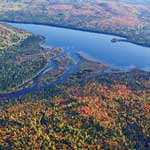
On July 28, 1857, Penobscot guide Joe Polis paddled his birch bark canoe across Eagle Lake to Pillsbury Island before returning to camp on the north shore of Chamberlain Lake, with Henry David Thoreau in the bow, and laden with 150 pounds of gear, to see the party safely from the shores of Moosehead Lake to Indian Island on the Penobscot River.
Thoreau was drawn north by a deep, philosophical interest in the wilderness, and his chronicle describes in detail the settlement of the region and the rapid expansion of timber harvesting. It’s clear even to the most casual reader of his Maine Woods that Thoreau was not happy with the impacts of social and economic forces upon the land.
A century after Thoreau’s travels, U.S. Supreme Court Justice William O. Douglas paddled these same ancestral Wabanaki headwater lakes explored by Polis and Thoreau, and he included the Allagash River in his seminal work, My Wilderness East to Katahdin (1961). Douglas was a passionate advocate for wilderness, and his was one of many voices raised in opposition to proposed hydroelectric development on the St. John River that would have flooded the Allagash south from its confluence with the St. John nearly to Allagash Falls.
Thanks to the advocacy of Justice Douglas and the leadership of Maine Senator Ed Muskie, as well as Natural Resources Council of Maine founders William Townsend and Robert Patterson, the legislature and people of Maine, created the Allagash Wilderness Waterway in 1966. Considered among the preeminent wilderness rivers in the country, the Allagash was designated a state-administered unit of the National Wild and Scenic River System in July 1970.

In 2011 several champions of the Allagash came together to create the Allagash Wilderness Waterway Foundation––the Friends of the Allagash––to support and protect the wild character of the Waterway, and to add a measure of excellence to its management by the Maine Bureau of Parks and Lands. AWWF set to work almost immediately to introduce young people from the region to the Waterway, and to assess the human, cultural, and natural resources of the extraordinary 92-mile Waterway.
Lumbering activity that Thoreau observed in 1857 continues today around the Waterway; and thanks to the AWWF’s comprehensive surveys and assessment of the forests, wetlands, and lake and river shores of the Waterway, we know that this gem in the crown of Maine’s public parks is a repository and refuge of life that hangs-on as an outstanding, healthy, and mature ecosystem.
Wilderness paddlers have been drawn to the Allagash in the wake of Joe Polis’s birch bark canoe for over 165 years. Today, the AWWF exists to help preserve and protect the Allagash, its multi-storied and near-primeval forests and wetlands, native cold-water fisheries, wood turtle haunts, and much more in the face of a rapidly changing climate.
For more information about the Allagash and the programs and good works of the AWWF, visit awwf.org, and consider becoming a Friend of the Allagash.
This page is sponsored by the Ocean Ledges Fund of the Maine Community Foundation with the goal of supporting education and conservation.







